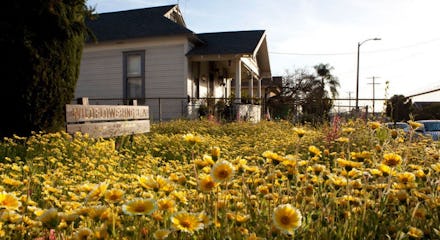Why One Artist Is Planting Wildflowers All Over Los Angeles

Right now, despite a drought, 50 formerly barren lawns in Los Angeles County are blooming with riotously colorful wildflowers. In a part of the country known for manicured lawns and gardens, artist Fritz Haeg has been working with local residents and community leaders to bring the natural flora back to the landscape. It's art, history and environmental awareness all rolled into one.
In front of homes, schools, churches, botanic gardens, public parks and one post office, the vibrant flowers have taken over, forming a living art project with a great message. Haeg's Wildflowering L.A. is bringing renewed awareness to urban environmentalism in a city that's not exactly known for being eco-friendly.
Image Credit: Ryan Benoit via The Horticult
Fritz Haeg, Wildflowering L.A., 2013-2014. A LAND (Los Angeles Nomadic Division) Exhibition. Image Credit: Isabel Avila.
"Age-defying thirsty landscapes of clipped evergreen shrubbery and lawns cover this city that supposedly has no seasons, no sense of time, and an aversion to all evidence of aging or death," Haeg wrote in his artist statement.
Haeg wanted to change all that by reintroducing the wildflowers native to those areas — areas where it can be easy to forget that natural flora ever existed at all. Last fall, he put out a call for participants with plots of land visible from the street, ultimately selecting 50 sites. With the help of LAND (Los Angeles Nomadic Division) and the Theodore Payne Foundation, he provided the landowners with one of four custom-made seed mixes based on their location.
Image Credit: Ryan Benoit via The Horticult
No stranger to environmental art, Haeg is also responsible for the Edible Estates project, which helps suburban residents plant vegetable gardens on their lawns. Though you're not likely to find much environmental art in traditional museums, probably because of its ephemeral nature, the medium has a strong history, particularly in the 1960s when artists used environment and ecology to challenge the restrictions of painting.
More recently, cities across the United States have been taking steps toward sustainability. Los Angeles in particular is making long strides. Last fall, around the same time that Haeg was sowing the seeds of this project, urban planning graduate students at UCLA published a study on the state of LA County's urban agriculture. In the battle against suburban sprawl, "[t]he biggest success story is, surprisingly, Los Angeles," Reid Ewing, a University of Utah professor who was the lead researcher on the Measuring Sprawl 2014 study, told The Atlantic.
Image Credit: Ryan Benoit via The Horticult
Image Credit: Ryan Benoit via The Horticult
Over time, human intervention has uprooted many of the plant species native to the Los Angeles area. Wildflowering L.A. has brought them back, beautifying the city and sustaining the eco-system in the process. Haeg is encouraging Angelenos to take the initiative into their own hands by participating in educational workshops and family activities. Though the flowers will wither and die over the course of the summer, they will return next spring. And if the project opens peoples' eyes to the natural, wild beauty that once was, well, then mission accomplished.
Fritz Haeg, Wildflowering L.A., 2013-2014. A LAND (Los Angeles Nomadic Division) Exhibition. Image Credit: Isabel Avila.
Fritz Haeg, Wildflowering L.A., 2013-2014. A LAND (Los Angeles Nomadic Division) Exhibition. Image Credit: Isabel Avila.
Fritz Haeg, Wildflowering L.A., 2013-2014. A LAND (Los Angeles Nomadic Division) Exhibition. Image Credit: Isabel Avila.
Fritz Haeg, Wildflowering L.A., 2013-2014. A LAND (Los Angeles Nomadic Division) Exhibition. Image Credit: Isabel Avila.
Fritz Haeg, Wildflowering L.A., 2013-2014. A LAND (Los Angeles Nomadic Division) Exhibition. Image Credit: Isabel Avila.
Image Credit: Ryan Benoit via The Horticult